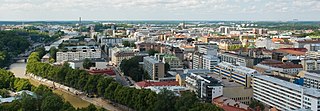
Turku is a city in Finland and the regional capital of Southwest Finland. It is located on the southwestern coast of the country at the mouth of the River Aura. The population of Turku is approximately 206,000, while the metropolitan area has a population of approximately 315,000. It is the 6th most populous municipality in Finland, and the third most populous urban area in the country after Helsinki and Tampere.

Porvoo is a city in Finland. It is located on the south coast of the country, on the Gulf of Finland. Porvoo lies in the eastern part of the Uusimaa region. The population of Porvoo is approximately 52,000, while the sub-region has a population of approximately 60,000. It is the 19th most populous municipality in Finland, and the 15th most populous urban area in the country.

Finland attracted over 6.8 million foreign tourists in 2018, with 53 percent coming from other European Union states. In 2017, the value added by tourism was about 4.6 billion euros, or 2.6% of the Finnish GDP, providing approximately 140,200 jobs.
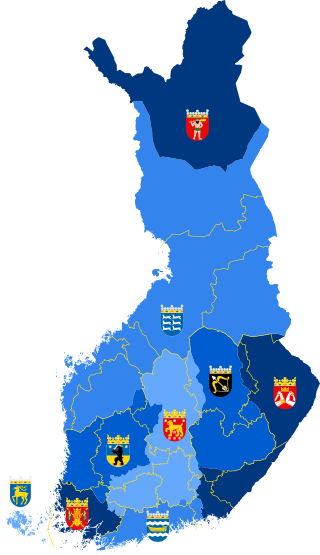
The historical provinces are former administrative or cultural areas of Finland, with origins from the slottslän of the Middle Ages. The historical provinces ceased to be administrative entities in 1634 when they were superseded by the counties, a reform which remained in force in Finland until 1997. The historical provinces remain as a tradition, but have no administrative function today.

Erik Eriksson, sometimes known as Erik XI or with the epithet the Lisp and Lame, was King of Sweden from 1222 to 1229 and again from 1234 to 1250. Being the last ruler of the House of Erik, he stood in the shadow of a succession of powerful jarls, especially his brother-in-law Birger Jarl, whose descendants ruled as kings after his death.
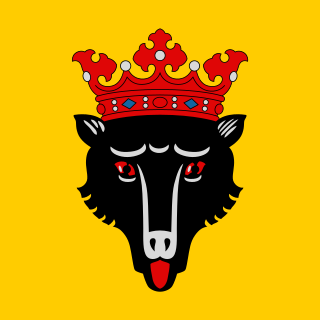
Pori is a city in Finland and the regional capital of Satakunta. It is located on the west coast of the country, on the Gulf of Bothnia. The population of Pori is approximately 83,000, while the sub-region has a population of approximately 128,000. It is the 10th most populous municipality in Finland, and the eighth most populous urban area in the country.

In local government, a city hall, town hall, civic centre, guildhall, or municipal building is the chief administrative building of a city, town, or other municipality. It usually houses the city or town council and at least some other arms of the local government. It also often functions as the office of the mayor, if the relevant municipality has such an officer. In large cities, the local government is often administratively expansive, and the city hall may bear more resemblance to a municipal capitol building.
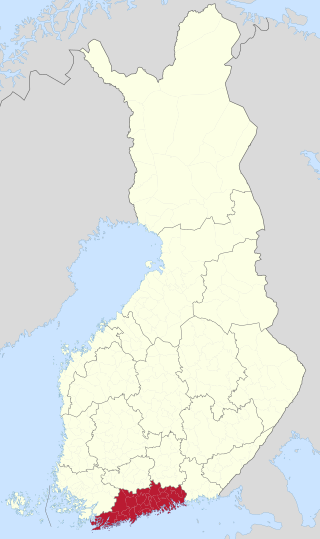
Uusimaa is a region of Finland. It borders the regions of Southwest Finland, Tavastia Proper (Kanta-Häme), Päijänne Tavastia (Päijät-Häme), and Kymenlaakso. Finland's capital and largest city, Helsinki, along with the surrounding metropolitan area, are both contained in the region, and Uusimaa is Finland's most populous region. The population of Uusimaa is 1,734,000.

Kokemäki is a town and municipality in the Satakunta Region of Finland. The town has a population of 6,710 and covers an area of 531.27 square kilometres (205.12 sq mi) of which 50.04 km2 (19.32 sq mi) is water. The population density is 13.97 inhabitants per square kilometre (36.2/sq mi).

Naantali is a town in Southwest Finland, and, as a resort town during the summer, an important centre of tourism in the country. The municipality has a population of 20,107 (31 October 2024), and is located 14 kilometres (8.7 mi) west of Turku.
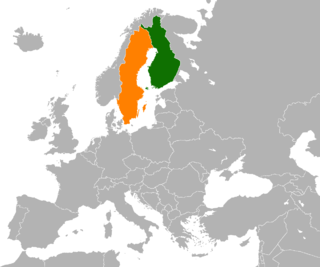
Finland and Sweden share a long history, similar legal systems, and an economic and social model. Finland was part of Sweden for almost 700 years from around 1150 until the Finnish War of 1809 after which Finland became an autonomous part of the Russian Empire as the Grand Duchy of Finland. Since Finland gained its full independence from Russia in 1917, Finland and Sweden have been close partners, enjoying a special relationship. The number of Finnish-Swedish connections and the quality of cooperation in most areas of the government is unique when compared to other international relations involving both countries. The Swedish language has an official status in Finland, whilst Finns form the largest ethnic minority in Sweden, estimated to be about 675,000.

The Medieval Market of Turku is an annual historical reenactment event organised in the historic city centre of Turku, Finland. Admission to the event is free. In addition to living history performances, it includes an open-air handicrafts market with vendors and even visitors garbed in period costume. The main market is at the Old Great Square, but there are other performances and exhibitions at Turku Castle, Turku Cathedral and at the Aboa Vetus & Ars Nova Museum. Together these different performances and exhibitions form the Medieval Turku event, which is organized in unison by Turun Suurtorin keskiaika ry, the Museum Centre of Turku, the Aboa Vetus & Ars Nova museum, Rohan Stables and Turku and Kaarina Parish Union. These areas are closed to traffic during the event.

The Second Swedish Crusade was a military expedition by the Kingdom of Sweden into Tavastia (Häme) in southern Finland described by Erik's Chronicle. According to the chronicle, the Swedes defeated the pagan Tavastians under the leadership of Birger Jarl, and started building a castle in Tavastia.

MS Baltic Star is a cruise ship owned by Rederi Hotell Fartyget BJ AB that was operated on services between Stockholm, Sweden and Helsinki, Turku and most recently Mariehamn on Åland (Finland). She was built in 1953 as a passenger liner at Finnboda shipyard in Nacka, Sweden as SS Birger Jarl for Rederi AB Svea. In 1973 she was sold to Jakob Lines, was renamed SS Bore Nord and converted into a ferry. In 1978 she was bought back by the Ånedin Line and was renamed SS Baltic Star. In 1982 the ship's original steam engines were replaced by diesel engines; the ship's prefix hence altered to MS. In 1989 the engines were again replaced by new diesels. In 2002 the ship reverted to the name Birger Jarl, and in 2020 back to the Baltic Star name.

Sastamala is a town in Finland, located in the Pirkanmaa region. Sastamala lies on both sides of River Kokemäenjoki in the southwest corner of Pirkanmaa. The population of Sastamala is approximately 24,000, while the sub-region has a population of approximately 26,000. It is the 44th most populous municipality in Finland.

The Old Great Square is a medieval market square located in the city centre of Turku, Finland. It is located in the II District in very close proximity to Turku Cathedral. The area was the administrative and commercial centre of Turku since the founding of the city in the 13th century up until the Great Fire of Turku.

Tartu Town Hall is the seat of the city government of Tartu, Estonia. It is located on Town hall square, in the city centre.

Turku is Finland's oldest city, having been founded in 1229. The city has a history as part of Sweden, Russia, and finally as an important city of independent Finland. Turku played a pivotal role during the Middle Ages as part of the Kingdom of Sweden. In the 16th century, it was the second most important city in the kingdom, after Stockholm. Turku served as the administrative, academic and religious centre of the eastern part of the Swedish kingdom, known today as Finland.

The Porvoo Town Hall is a former town hall and current museum in Porvoo, Finland. It is located in the old town of Porvoo, in the immediate vicinity of the market square.

























